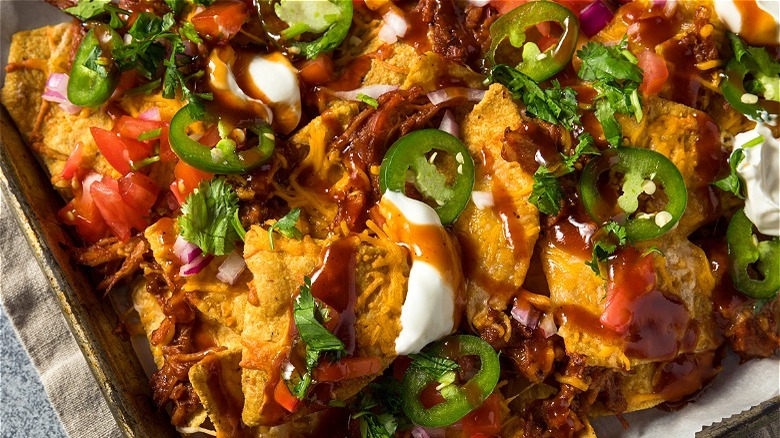What In The World Is Cowboy Candy? (And Is It Actually Candy?)
We all have an image or stereotype that comes to mind when we think about cowboys. Whether you picture the wild west or rugged men wearing sleek pinched fronts atop their heads, cowboys, based on their first appearances in history, happened to be none other than highly skilled cattlemen moving from place to place, living off the land, and trying to make a living. At mealtime, easy-to-prepare dishes that stuck to your bones were most preferred. Meat, beans, coffee, hard biscuits, and fruit (when available) were Western cowboy staples. Fast forward to the 21st century and even though modern conveniences have cushioned life on the range, the concept of cowboy cooking remains. Most of today's modern cowboy recipes, include cast iron pans, open fires, and basic ingredients to make delicious meals.
Modern times have brought us delights such as cowboy butter, and, more specifically, cowboy caviar, which happens to be a Texas mainstay comprised of black-eyed peas, corn, and tomatoes. While these modern dishes may be a little more sophisticated than coffee boiled over an open fire, present-day cowboy foods still pay homage to the olden days by way of simple ingredients and low-prep enjoyment. While you may have heard or eaten those before, have you ever come across cowboy candy? Though what is it exactly? After all, cowboys weren't necessarily chowing down on packaged candy bars on the open range in the 1800s. Is cowboy candy actually an indulgent confection or a twist on something known? Let's dive in.
Cowboy candy explained
Truth be told, American cowboys in history did indulge in confections from time to time. While peppermints may have been the candy of choice in the 1800s, today's cowboy "candy" many ranchers and foodies have come to enjoy is actually candied jalapeños. The first candied jalapeño recipe was supposedly developed by Mindie Heironimus in 1922. As the story goes, her parents worked as farmers while she took care of the housework, which often included cooking and preserving. With an abundance of jalapeños from one year's harvest, Heironimus pickled not only cucumbers but jalapeños with a similar preservation method, and a new delicious treat was born.
While slightly similar to basic pickled jalapeños, candied jalapeños are made by cooking jalapeños in a tangy, sugary brine until some of the liquid has been reduced and the jalapeños soften. Once the jalapeños are moved to jars, the reserved liquid is poured back over the partially cooked jalapeños. After cooling, these candied jalapeños are best stored in the refrigerator for up to four weeks. Moreover, since candy is defined as a treat made with sugar, candied jalapeños do fall under the category of candy in some regard. However, besides popping a "piece" or two of cowboy candy to satisfy your spicy sweet cravings, candied jalapeños are also added to several dishes, serving as a delightful flavor enhancer in lieu of traditional pickled or chopped jalapeños.
Delicious ways to use cowboy candy
People who enjoy spicy and sweet flavors all in one bite can't get enough of candied jalapeños. Beyond eating these flavorful peppers right out of the jar, cowboy candy is easy to add to many of your favorite meals. First off, if you're looking for an easy appetizer, simply pour candied jalapeños and the sugary syrup over a block of cream cheese and serve with crackers. The creaminess of the soft cheese will balance the tangy acidity of the peppers. Alternatively, you can add them right atop your favorite meals for an extra kick. Whether on top of pulled pork sandwiches, nachos, hot dogs, or even with a scoop or two added to your favorite homemade dips can enhance the overall complexity of your most cherished recipes.
If you're feeling extra creative you can even use cowboy candy to level up your favorite spicy margarita recipe. The options are truly endless. For those who often have a hankering for hearty, ranch-style fare, give up your tried and true cast iron jalapeño cornbread for a while and try adding candied jalapeños to your next brisket or hamburger skillet. After all, an integral part of cowboy cooking is finding new creative ways to use the same reliable ingredients.


